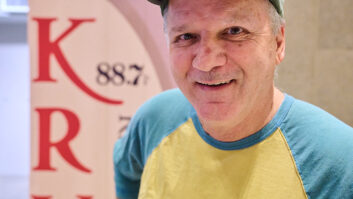
The Wall Street Journal’s TV studio fits in its newsroom. Note the small footprint and automated cameras on the tripods. Ask anyone of a certain age what the Wall Street Journal is, and they’ll almost immediately think of the traditional newspaper.
But the younger the respondent, the more likely they’ll mention it’s a website, video producer or even a radio program. The fact is, the WSJ, like so many of its former print-only newspaper industry confreres, isn’t simply a large-circulation newspaper — but is rather an international multimedia content producer.
IT’S RADIO TIME
John Wordock is happy to briefly reminisce about his days as a starry-eyed 17-year-old sports announcer at Portland, Maine’s WMER(AM) 1440. Very briefly.
Then he moves on to the here and now.
Wordock is quite busy as the executive editor of both the Wall Street Journal and MarketWatch radio networks. Plus he oversees the nationally-syndicated “WSJ This Morning.” Over 600 radio affiliates, some 30 million listeners, 90 percent national market penetration — those are the numbers. In major markets like Manhattan, you cannot escape it, with 24/7 programs on WABC, WCBS and WINS. Plus, there’s iTunes, iHeartRadio, SoundCloud and Stitcher. Wordock’s goal is to meet WSJ listeners where they are, all day, every day, on every device imaginable, in multiple length formats, from one-minute to one-hour features. Did I mention Facebook and Twitter, too?
And all this is accomplished with “fewer than three dozen anchors, reporters and producers to keep the needle moving,” Wordock said.
“Remember the famous Wayne Gretzky quote about how he scored so many goals in hockey?” Wordock said. “’You got to go to where the puck is going to be.’ So we are in the process of going to where the listeners are going to be.”
When we first spoke, Wordock had just returned from the Washington Auto Show and, no, he wasn’t kicking tires. “I was marveling at how the digital dashboard has become an entertainment center for consumers and drivers. Ford is leading the charge, and GM is heavily involved. My job is to get us on those dashboards. Is that radio? Is that digital audio? Both, actually.”
Wordock’s up-close and personal style is evident as he responds to listener emails, even about seemingly obscure stuff.
“The ‘Wall Street Journal This Morning’ syndicated show uses bumper music, and we often get requests or compliments about the various songs. Maybe we’ll play 10 seconds of Jimmy Hendrix or the Foo Fighters that catches someone’s ear buds. Just like that, they’ll dash us off a note from their device,” said Wordock. “It’s very, very cool to have listeners who are engaged with us.” (Cool, yes, but those listeners are customers, too, and they expect answers!)
CORD CUTTER
One significant, recurring Wordock theme is more and more reliance on IP wireless technology versus so-called “hardwires,” a fact driven home when superstorm Sandy literally drowned their ISDN capability, seemingly for months.
Not surprisingly, Wordock cut the copper cord long ago.

Screenshot of Jason Bellini and Joe White on the Air A classic example: he was in Austin on National Donut Day. Wordock found a shop that made awesome, fiery habanero donuts, breathlessly recorded the experience using the memo function on his iPhone, emailed the file to a WSJ producer — Boom! He was on the air in minutes. Just like the good old days, doing football broadcasts, donuts and all — but this time, the studio front-end was in his pocket.
Unlike veteran broadcaster Wordock, other WSJ staffers, many from the print side, needed to learn on-air skills. The WSJ instituted an in-house cross-training program for writers and producers to become effective presenters for both audio and video formats.
Story conferences and content decisions invariably revolve around multimedia usage, to expand distribution on multiple channels and amortize costs, plus adding value to products throughout the chain. Tapping and training in-house assets, i.e. “the talent,” is a big part of that program. Multiple skill-sets are crucial for employability, especially for an increasingly independent and mobile multitasking WSJ staff.
While keeping the WSJ’s audio/radio content profitable is an enormous responsibility, Wordock still has the heart of that 17-year old high school student who got his first break in local AM radio. However, he now has the added perspective of a network executive.
“Radio is very, very intimate. And we have to keep in mind that we need to make a connection with our listener and make sure that they feel comfortable with us at all times,” he said. “That means we need to go mobile, as radio has the potential to have a very massive rebirth, because everyone who has a smartphone out there has a radio in their pockets. Station managers, GMs, PDs and news directors have to realize that, because of this phenomenon, we have a chance to really regain what has made radio great over the years.”
MULTIMEDIA
The Wall Street Journal’s Jason Bellini and Joe White love cars, especially Lamborghini’s new $200,000 Huracán, with a 600 HP V-10 that propels the machine to over 200 mph.
They also love their jobs and are dedicated to sustaining personal employability, by developing diverse, dynamic multimedia skill sets. Those skills were on display as I watched the two on the WSJ Live “Lunch Break.” Bellini, senior producer and on-air talent and White, global auto editor for the WSJ, both gushed on about the Huracán’s carbon fiber skin, smoking tires and how Lamborghini manages product scarcity.
The side-by-side live interview features White, casually but appropriately dressed, in his home office, speaking into an Audio-Technica ATR2500-USB mic connected to his laptop computer. A video insert, “Detroit via Skype” floats above his head.

Christopher Springmann does his show here from poolside in Atlanta. He packs an Audio-Technica BP4073 shotgun and a Shure X2u USB adapter along with his camera. With those tools he’s able to do high-quality audio from anywhere. Bellini, by contrast, wears a sharply tailored suit and stands at the WSJ Live anchor desk, in front of the show’s logo, an effect dropped onto a green screen behind him. The production-rich, fast-paced segment features “two shots” of the talent in conversation plus rotating facial close-ups to vary the action, all intercut with b-roll of the smokin’ Huracán, plus graphic treatments and closed captioning.
Closed captioning is crucial, as the show appears in noisy airports, bars and retail stores, in front of hearing-impaired and ESL audiences plus folks at work who watch silently.
Their professional performance, backed up by staff technical support, was not coincidental. Before joining the WSJ, Bellini spent four years at CNN doing field production, where his tools were a laptop and video camera, plus excellent editing skills. Bellini, a “seasoned veteran” at 38, also produces and hosts in three–four weekly segments of “The Short Answer,” a two+-minute news feature that often includes “user-generated content;” that is, clips supplied by the featured guest, sent via Instagram (0:15 sec. max. each upload) or posted to the WSJ’s FTP site. He’s also taken advantage of the WSJ’s coaching and media training opportunities.
CAREER TRAJECTORY
Joe White, another graduate of WSJ broadcast media classes, is a self-described old-school print journalist who has been on the Detroit auto beat for two decades. He now thinks like a producer and acts as director, managing reporters, coordinating interviews, but always, all-ways, considers the visual components of the story first.
“I think a lot of our younger readers are going to absorb what we have to say about the auto industry more readily through a two-to-three-minute video,” White said. “You’ve got to be able to put your ideas across in whatever form the customer wants. A 1,000-word print story and all the depth? We’ve got that. Hear me talk on the radio for two minutes? I do that, too. There are a lot of people who know me, not from the print Journal, but through broadcast media, no doubt about it. The audiences don’t necessarily overlap.”
White’s advice to up-and-comers or pros making the transition to multimedia?
“Get involved in acting, as that training, the ability to get up on stage and project, has been invaluable in my unexpected career turns over the last 10 years,” White said.
Jason Bellini’s career trajectory and especially that of Joe White, have paralleled my own path: newspapers, acting, publications and magazines, radio and video, multiple career changes compelled by aesthetic, creative and, yes, economic necessity.
My choices of technology-and-tools are amazingly similar to theirs, all driven by the necessity to produce a quality product on the road, especially great audio. (Rush Limbaugh’s show video has all the sexiness of watching a fixed-camera underground parking lot CCTV feed, but he sounds great.) White, who is also a guitarist, saw a “Deal of the Day” on his favorite musician’s site and impulsively picked up the Audio-Technica ATR2500-USB mic. That buy changed his life and the quality of his work on-air. Yes, the built-in webcam on the Apple laptop still produces acceptable video, but the Audio-Technica mic made him sound like a star.
It’s an important lesson that can’t be underestimated.
Much like Bellini and White, I bounce between home, studio and locations like hotels, airports and the backseat of rent-a-cars; thus, I now only use small, lightweight shotgun mics, the Audio-Technica BP4073 for narration and VO. It’s easy to pack at 9 inches and 3.5 ounces, has great presence plus a bit of urgency, often called the “L.A. Sound.”
For my Canon Xa10 video camera, which has two phantom-powered XLR plugs, I use an Audio-Technica AT897, an unobtrusive 11-inch, 5-ounce shotgun, which also operates with a standard AA battery, great for the back-up consumer-model Canon video camera or a DSLR without XLR/phantom power capabilities.
If someone had told me 10 years ago, when I was working on newsmagazines, trade journals and corporate annual reports, that I’d be shooting video and cutting audio on the run, I’d have thought they were nuts. But like the Wall Street Journal personnel I spoke with, we are all evolving into multimedia content producers.
Christopher Springmann is the producer of the syndicated “Life, Love & Health” health talk show.












